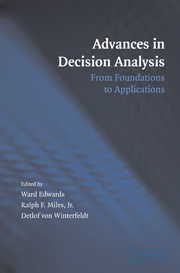Book contents
- Frontmatter
- Contents
- List of Contributors
- Preface
- 1 Introduction
- PART I HISTORY AND FOUNDATIONS OF DECISION ANALYSIS
- PART II STRUCTURING DECISION PROBLEMS
- PART III PROBABILITIES AND BAYES NETS
- PART IV UTILITIES
- PART V RISK ANALYSIS
- PART VI DECISION ANALYSIS IN A BEHAVIORAL AND ORGANIZATIONAL CONTEXT
- 18 What Have We Learned from Our Mistakes?
- 19 Decision Conferencing
- 20 Resource Allocation Decisions
- 21 From Decision Analysis to the Decision Organization
- 22 Building Decision Competency in Organizations
- 23 Negotiation Analysis: Between Decisions and Games
- PART VII APPLICATIONS OF DECISION ANALYSIS
- Index
- References
18 - What Have We Learned from Our Mistakes?
Published online by Cambridge University Press: 05 June 2012
- Frontmatter
- Contents
- List of Contributors
- Preface
- 1 Introduction
- PART I HISTORY AND FOUNDATIONS OF DECISION ANALYSIS
- PART II STRUCTURING DECISION PROBLEMS
- PART III PROBABILITIES AND BAYES NETS
- PART IV UTILITIES
- PART V RISK ANALYSIS
- PART VI DECISION ANALYSIS IN A BEHAVIORAL AND ORGANIZATIONAL CONTEXT
- 18 What Have We Learned from Our Mistakes?
- 19 Decision Conferencing
- 20 Resource Allocation Decisions
- 21 From Decision Analysis to the Decision Organization
- 22 Building Decision Competency in Organizations
- 23 Negotiation Analysis: Between Decisions and Games
- PART VII APPLICATIONS OF DECISION ANALYSIS
- Index
- References
Summary
ABSTRACT. The authors discuss the steps involved in good decision making and use those steps to organize results from behavioral decision research. Framing effects, self serving biases, and context effects are a few of the many errors and biases that are presented. The authors also discuss techniques for reducing errors. They conclude by providing examples of human cognitive strengths, while emphasizing the importance of learning from our mistakes.
Good Decision Making
To the lucky few, good decisions come naturally. But to most of us, decisions are difficult, grueling, and sometimes quite painful. The process requires us to make delicate tradeoffs, sort through complex scenarios, hunt for good ideas, estimate the odds of future states, and answer a voice inside that keeps asking, “Is this what I really want?”
Many scholars describe good decision making as a series of interrelated steps. Although there are many ways to categorize steps, most researchers agree that the process includes the following stages:
Define the Problem and Set the Goals
The best way to get what you want is to know what that is. This step could be extremely easy or extremely difficult depending on the problem. Good decision makers ask, “What do I want to achieve? What are my goals and objectives? How will I know if I am successful?”
Gather Information and Identify Options
Important choices require a careful and unbiased search for evidence. Normative theory says that the search for information should continue until the costs outweigh the benefits.
- Type
- Chapter
- Information
- Advances in Decision AnalysisFrom Foundations to Applications, pp. 351 - 374Publisher: Cambridge University PressPrint publication year: 2007
References
- 4
- Cited by



